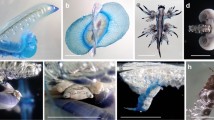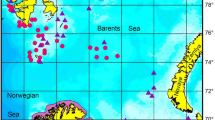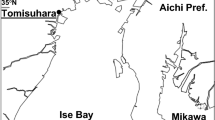Abstract
The reproductive development of three species of the Petrosida, Xestospongia bergquistia, X. exigua, and X. testudinaria, was monitored for four years on a fringing reef at Orpheus Island, Great Barrier Reef, Australia. All three species were oviparous and female reproductive activity began prior to males becoming active. X. bergquistia and X. testudinaria were gonochoric and broadcast eggs in spawning events that were synchronous within species. Egg development occurred over more than five months in X. bergquistia and X. testudinaria and two months in X. exigua. Spawning was during periods of warm temperature and occurred in October or November for X. bergquistia and X. testudinaria, and January or February for X. exigua. Lunar phase was implicated in timing of spawning of X. testudinaria. Diel timing of spawning in X. testudinaria and X. bergquistia was consistently a morning event.
Similar content being viewed by others
References
Ayling AL (1980) Patterns of sexuality, asexual reproduction and recruitment in some subtidal marine Demospongiae. Biol Bull 158:271–282
Battershill CN, Bergquist PR (1990) The influence of storms on asexual reproduction, recruitment, and survivorship of sponges. In: Rützler K (ed) New perspectives in sponge biology. Proc Third Int Conf Sponges: 397–403
Bergquist PR (1978) Sponges. Hutchinson, London
Bergquist PR (1980) The ordinal and subclass classification of the Demospongiae (Porifera); appraisal of the present arrangement, and proposal of a new order. NZ J Zool 7:1–6
Bergquist PR, Sinclair ME, Hogg JJ (1970) Adaptation to intertidal existence: reproductive cycles and larval behaviour in Demospongiae. Symp Zool Soc London 25:247–271
Crisp DJ (1977) Genetic consequences of different reproductive strategies in Marine Invertebrates. In: Baltaglia B, Beardmore JA (eds) Marine organisms. Genetics, ecology and evolution. (NATO Conference Series IV Marine Sciences) Plenum Press, New York, 2:257–274
Diaz J, Connes R, Paris J (1973) Origine de la lignée germinale chez une Demospongiae de l'etang de Thau: Suberites massa Nardo. C R Acad Sci (Paris) 277:661–664
Fell PE (1983) 1. Porifera. In: Adiyodi KG, Adiyodi RG (eds) Reproductive biology of invertebrates, vol. 1: oogeesis, oviposition, and oosorption. Wiley, New York, pp 1–29
Fromont J (1988) Aspects of the reproductive biology of Xestospongia testudinaria (Great Barrier Reef). Proc Sixth Int Coral Reef Symp 2:685–691
Fromont J (1991) Descriptions of species of the Petrosida (Porifera: Demospongiae) occurring in the tropical waters of the Great Barrier Reef. The Beagle, Rec North Terr Mus Art Sci 8:73–96
Fromont J (1994) Reproductive development and timing of tropical sponges (Order Haplosclerida) from the Great Barrier Reef, Australia. Coral Reefs 13:127–133
Harrison PL (1985) Sexual characteristics of Scleractinian corals: systematic and evolutionary implications. Proc Fifth Int Coral Reef Symp 4:337–342
Harrison PL, Wallace CC (1990) Reproduction, dispersal and recruitment of scleractinian corals. In: Dubinsky Z (ed) Ecosystems of the world 25, coral reefs. Elsevier, Amsterdam, pp 133–207
Hoppe WF (1988) Reproductive patterns in three species of large coral reef sponges. Coral Reefs 7:45–50
Hoppe WF, Reichert MJM (1987) Predictable annual mass release of gametes by the coral reef sponge Neofibularia nolitangere (Porifera: Demospongiae). Mar Biol 94:277–285
Kojis BL (1986) Sexual reproduction in Acropora (Isopora) species (Coelenterata: Scleractinia) 1. A. cuneata and A. palifera on Heron Island reef, Great Barrier Reef. Mar Biol 94:291–309
Kojis BL, Quinn NJ (1981) Aspects of sexual reproduction and larval development in the shallow water hermatypic coral Goniastrea australiensis (=favulus) Edwards and Haime, 1857. Bull Mar Sci 31:558–573
Lévi C (1953) On a new classification of the Demospongiae. C R Acad Sci (Paris) 236:853–855
Lewandrowski KB, Fell PE (1981) Sequential reproduction by different types of specimens of the estuarine sponge, Halichondria sp., with an emphasis on reproduction of postlarval specimens. Int J Invert Reprod 3:227–236
Liaci L Scalera, Sciscioli M, Matarrese A (1973) A comparison between the sexual behavior of certain Ceractinomorpha. Riv Biol 66:135–162
Reiswig HM (1973) Population dynamics of three Jamaican Demospongiae. Bull Mar Sci 23:191–226
Reiswig HM (1976) Natural gamete release and oviparity in Caribbean Demospongiae. In: Harrison FW, Cowden RR (eds) Aspects of sponge biology. Academic Press, New York, pp 99–112
Sarano F (1991) Snychronised spawning in Indonesian sponges. Coral Reefs 10:166
Siribelli L (1962) Differenze nel ciclo sessuale di popolazioni conviventi di Axinella damicornis (Esper) ed Axinella verrucosa O.S. (Demospongiae). Ann Inst Mus Zool Univ Napoli 14:1–8
van Soest RWM (1991) Demosponge higher taxa classification re-examined. In: Reitner J, Keupp H (eds) Fossil and recent sponges. Springer, Berlin, Heidelberg, New York, pp 54–71
Watanabe Y (1978) The development of two species of Tetilla (Demospongiae). Nat Sci Rep Ochanomizu Univ 29:71–106
Wulff J (1990) Patterns of size change in Caribbean Demosponges of branching morphology. In: Rützler K (ed) New perspectives in sponge biology. Proc Third Int Conf Biol Sponges, pp 425–435
Author information
Authors and Affiliations
Rights and permissions
About this article
Cite this article
Fromont, J., Bergquist, P.R. Reproductive biology of three sponge species of the genus Xestospongia (Porifera: Demospongiae: Petrosida) from the Great Barrier Reef. Coral Reefs 13, 119–126 (1994). https://doi.org/10.1007/BF00300772
Accepted:
Issue Date:
DOI: https://doi.org/10.1007/BF00300772




